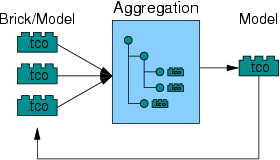|
The core of authoring system consists of two applications called Lyssa
and Nyx (Named after the Greek goddesses). The first program
is responsible for the creation of bricks and their combination to
higher structures. It stands for most of the functionality described
by the construction kit metaphor. Nyx is very important for the
translation process of the courses to the different layouts and media
types but is not as covered as Lyssa by the metaphor. Therefore, the
following text focuses on the functionality of Lyssa and the
collaboration with Nyx.
Figure~2 illustrates the process of model creation.
a) 
|
b) 
|
|
Figure 1: The Process of model creation
|
An abstract view on the aggregation process is shown in a). Lyssa
reads several bricks and aggregates them to one model. An important
aspect of the definition is the recursive use of models. Not only
bricks can be combined but also models. That allows an individual
structure of the contents and leads to several possibilities of reuse.
Now it is imaginable to create learning objects, structures, chapters
etc. with less effort.
The process with internal structure details is shown in b). In this
illustration a tree is used inside of Lyssa to arrange the different
bricks and models but every other kind of relation, e.g. list and
net, is conceivable. These different data structures influence the
appearance and the sequencing of the same content. For this reason,
Lyssa uses one independent list of all included bricks and allows the
definition of several navigation paths.
|

